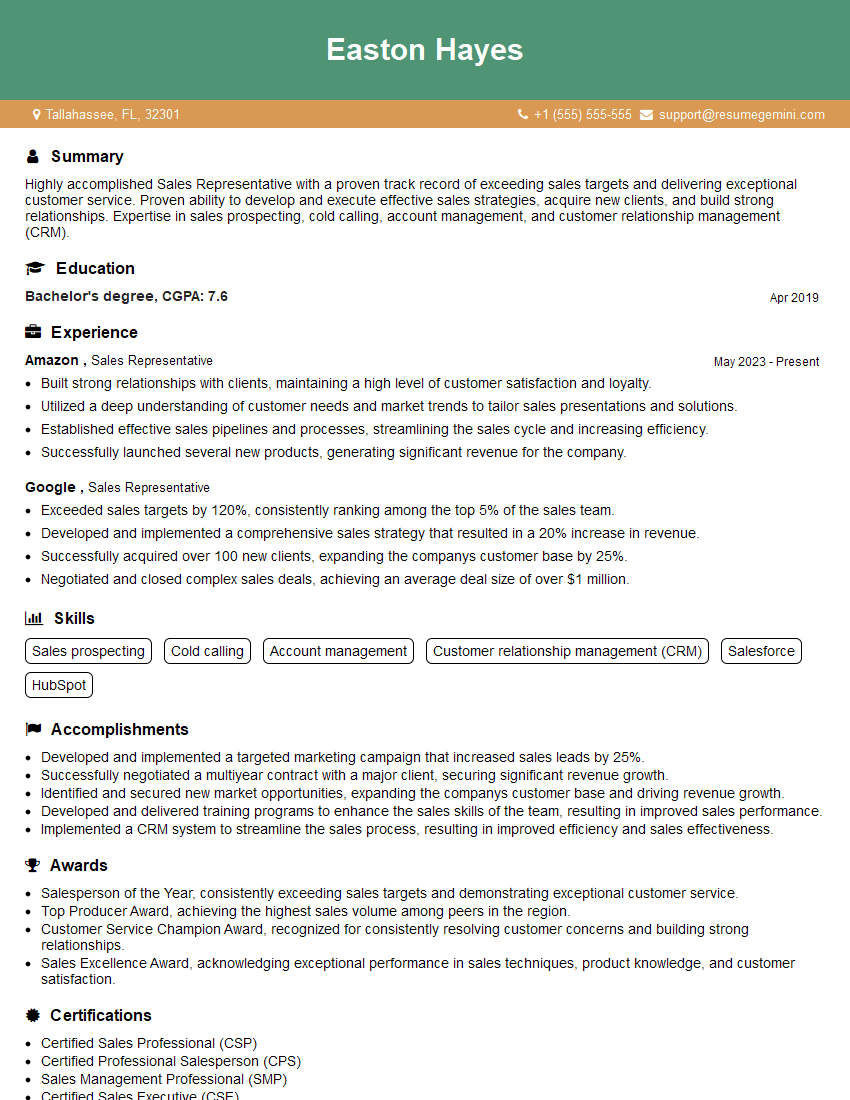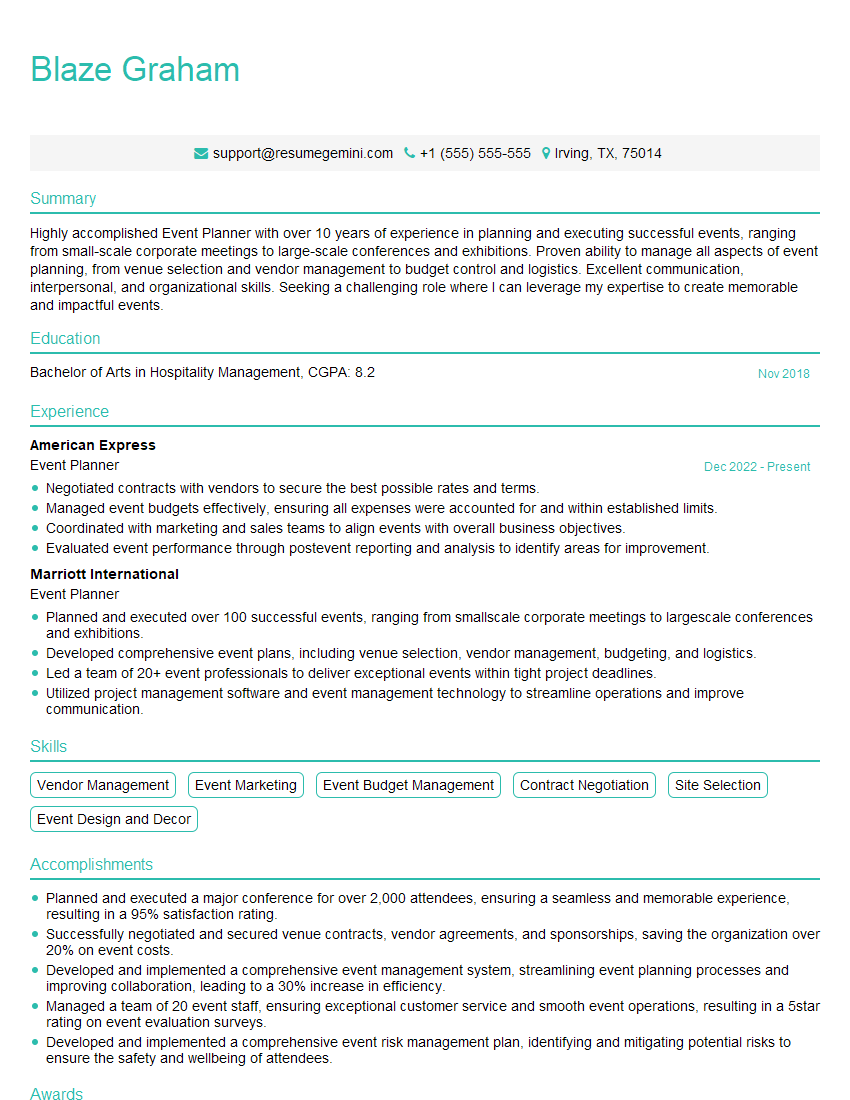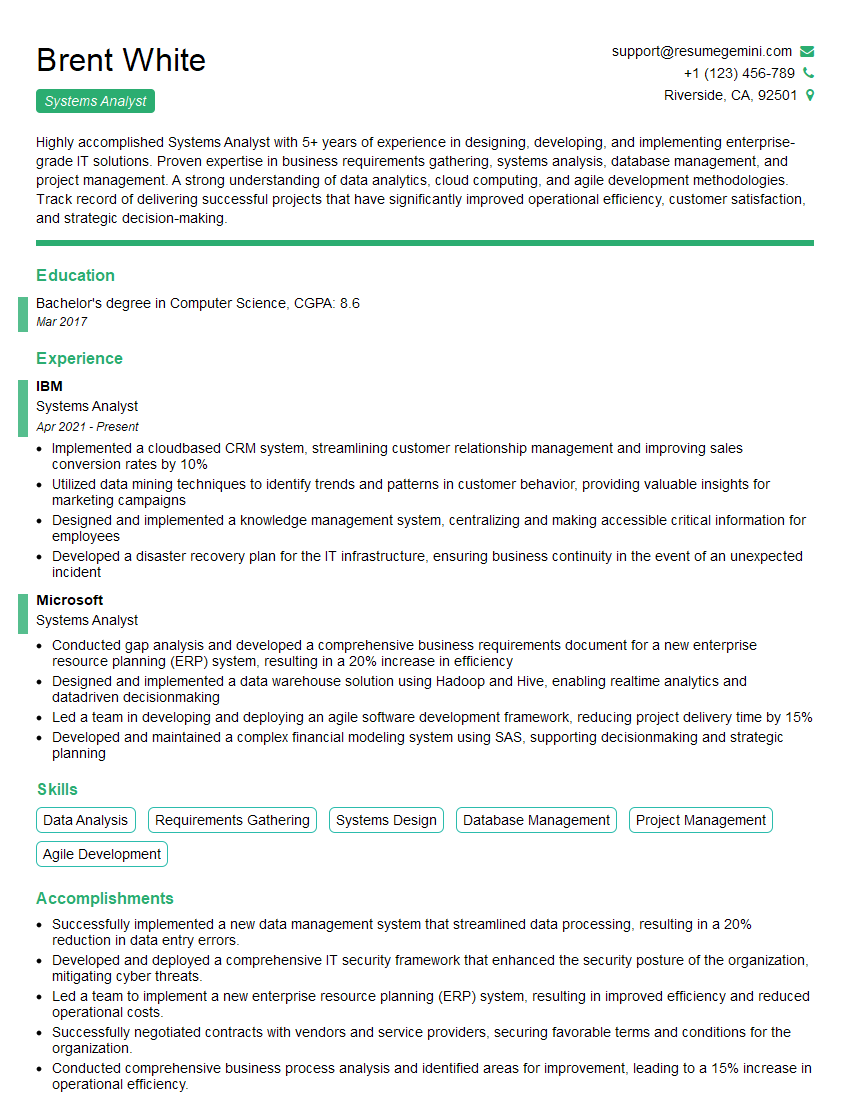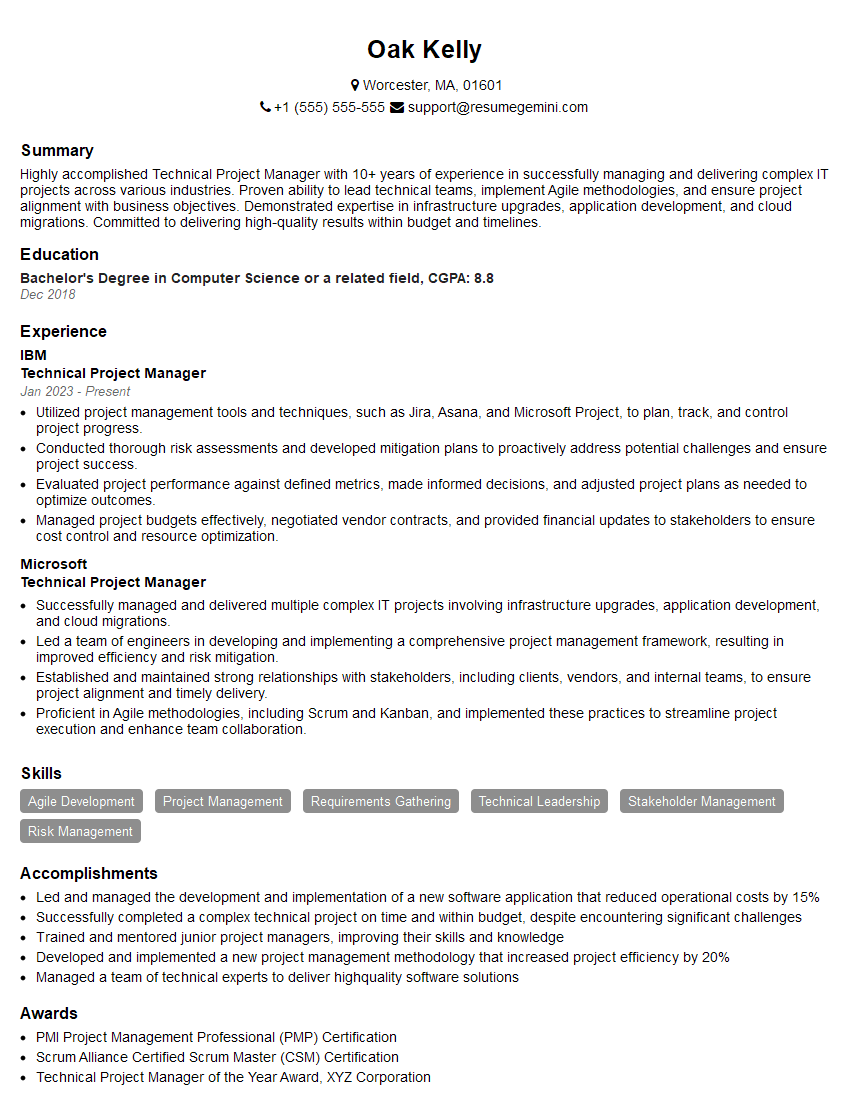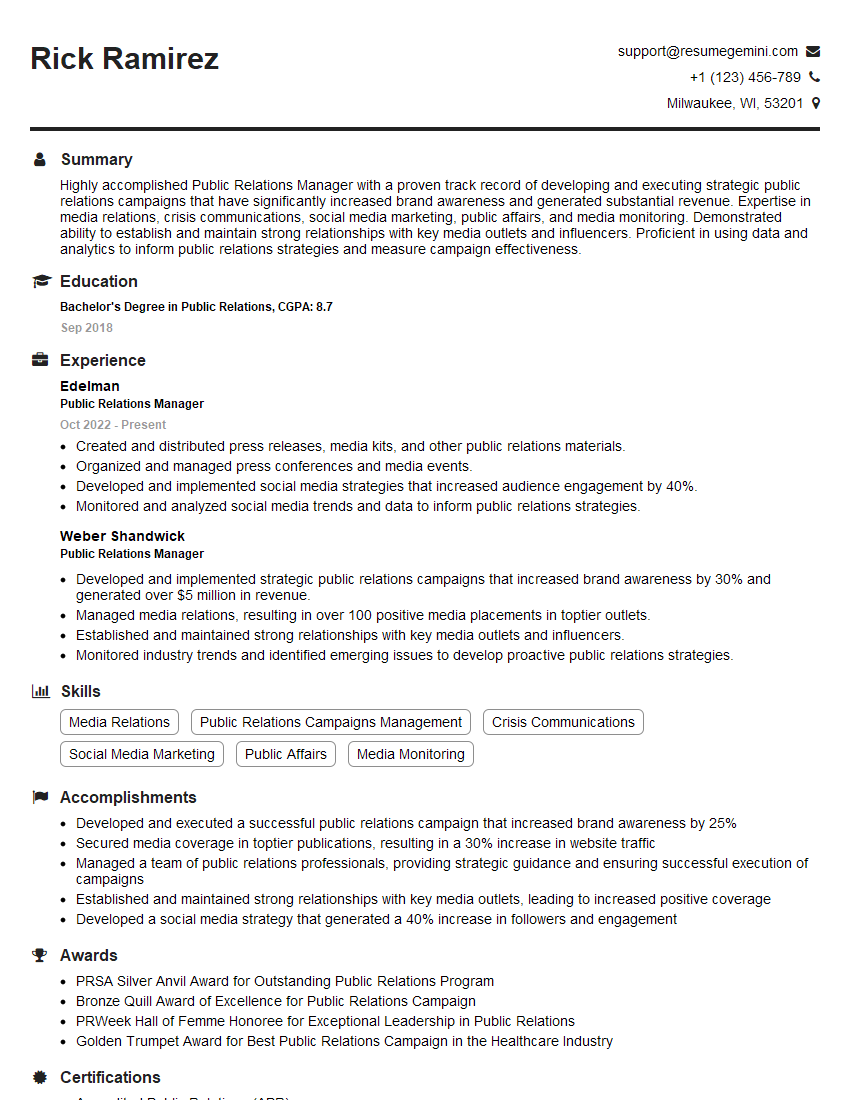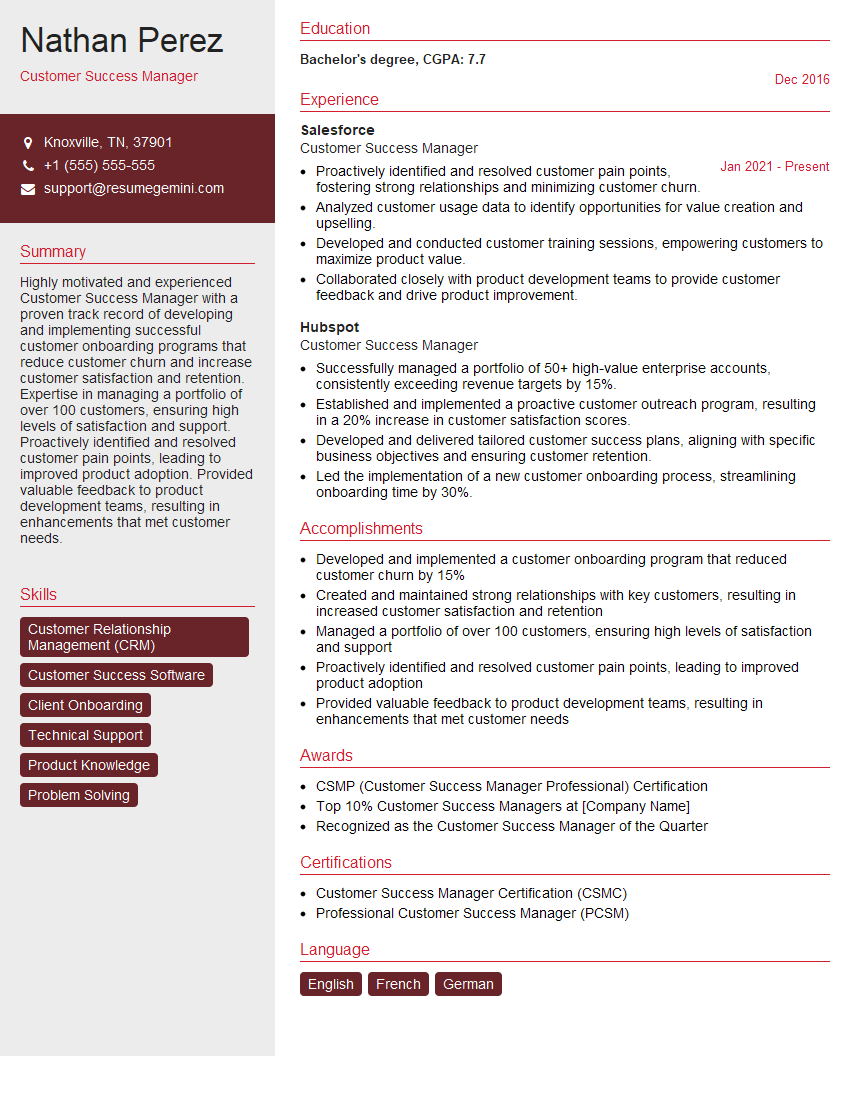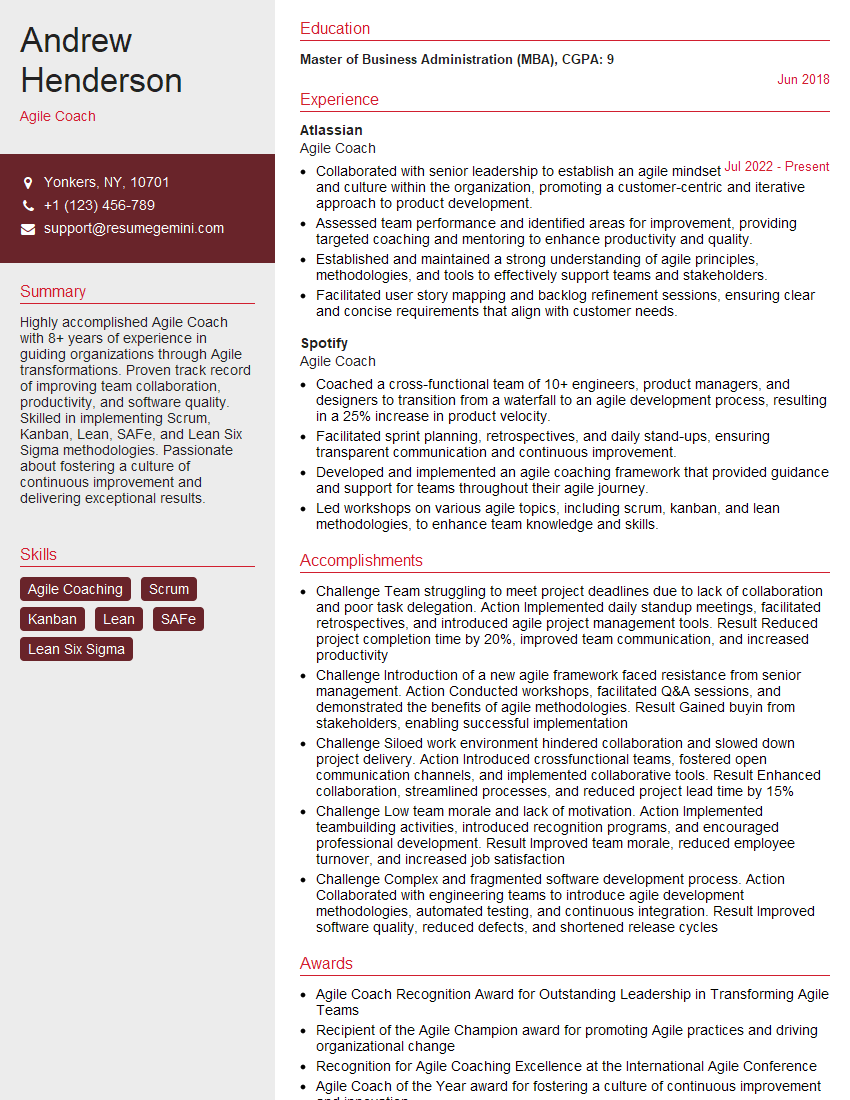Interviews are opportunities to demonstrate your expertise, and this guide is here to help you shine. Explore the essential Adaptability and Flexibility in a Fast-Paced Work Environment interview questions that employers frequently ask, paired with strategies for crafting responses that set you apart from the competition.
Questions Asked in Adaptability and Flexibility in a Fast-Paced Work Environment Interview
Q 1. Describe a situation where you had to adapt to a significant change in priorities.
Adaptability is crucial in today’s dynamic work environments. A significant change in priorities often requires a quick shift in focus and approach. For example, I was once leading a team developing a new software feature with a tight deadline. Two days before launch, a critical security vulnerability was discovered in a core component of the system, unrelated to our feature.
This demanded an immediate change in priorities. We paused our feature development, formed a crisis team, and prioritized resolving the security flaw. This involved intense collaboration with the security team, rapid debugging, and several late nights. We successfully patched the vulnerability and launched the update, demonstrating adaptability and a commitment to both project success and security.
My approach involves: Firstly, acknowledging the new priority and its implications; secondly, collaborating with stakeholders to understand the new requirements; thirdly, re-allocating resources effectively; and finally, maintaining transparent communication throughout the process. This whole situation highlighted the importance of prioritization, teamwork, and decisive action under pressure.
Q 2. How do you prioritize tasks in a high-pressure environment with competing deadlines?
Prioritizing tasks in a high-pressure environment requires a structured approach. I use a combination of methods to effectively manage competing deadlines. Imagine a scenario where you have several projects, each with different deadlines, stakeholders, and levels of urgency.
I begin by using a prioritization matrix, often a simple Eisenhower Matrix (Urgent/Important), to categorize my tasks. This helps me quickly identify urgent tasks that demand immediate attention and important tasks that contribute significantly to long-term goals, even if they’re not immediately pressing. I then assign each task a deadline and break down large tasks into smaller, manageable steps. Time blocking becomes essential – scheduling specific time slots for focused work on high-priority items.
Finally, I regularly review and adjust my priorities as new information emerges or circumstances change. It’s a dynamic process and being flexible is key. It’s also helpful to communicate proactively with stakeholders, ensuring alignment and managing expectations.
Q 3. Explain your approach to managing multiple projects simultaneously.
Managing multiple projects concurrently requires organization, time management, and strong communication skills. Think of it like conducting an orchestra: each project is a different instrument, requiring individual attention but working together harmoniously.
I utilize project management tools like Trello or Asana to track progress, deadlines, and dependencies between different projects. These tools help me visualize the workflow and identify potential bottlenecks. Clear communication with team members and stakeholders is also vital – regular updates, status reports, and open channels for communication avoid misunderstandings and ensure everyone is on the same page.
I also dedicate specific blocks of time to each project, avoiding multitasking, which often leads to decreased efficiency. Furthermore, I prioritize tasks based on their urgency and impact, ensuring that critical tasks for each project receive sufficient attention.
Q 4. Give an example of a time you had to quickly learn a new skill or technology.
Learning new skills or technologies is an ongoing process in a fast-paced environment. For instance, our team recently transitioned to a new CRM system. While I had experience with CRMs, this one had a unique interface and a set of specialized features.
To quickly adapt, I utilized the system’s built-in tutorials, explored online resources, and attended internal training sessions. I also actively sought help from colleagues who were already proficient with the new system. Hands-on practice, working on smaller tasks, helped me consolidate my learning. I found that actively using the system, experimenting with its features, and seeking feedback from peers was far more effective than simply reading documentation.
This experience reinforced the importance of active learning, seeking support from colleagues, and practical application for effective skill acquisition.
Q 5. How do you handle unexpected challenges or setbacks?
Unexpected challenges are inevitable. My approach involves a structured problem-solving process. Let’s say a critical piece of equipment fails during a crucial phase of a project.
First, I assess the situation calmly, identifying the impact of the setback. Next, I gather information from relevant sources, consulting with experts and team members. Then, I brainstorm potential solutions, evaluating their feasibility and potential risks. Once a solution is chosen, I implement it, monitoring progress and making adjustments as needed. Finally, I document the entire process, including lessons learned, to prevent similar issues in the future. This helps build resilience and improve our operational efficiency.
Maintaining a positive attitude and focusing on finding solutions rather than dwelling on the problem is essential for navigating unexpected challenges successfully.
Q 6. Describe your experience working in a fast-paced, dynamic environment.
I thrive in fast-paced, dynamic environments. My previous role at [Previous Company Name] involved working on multiple projects simultaneously, with frequently shifting priorities and tight deadlines.
The nature of the work demanded constant adaptability, strong communication, and the ability to handle pressure effectively. We were often involved in crisis management, requiring rapid problem-solving and collaborative efforts across different teams. This experience honed my skills in prioritization, time management, and decisive decision-making under pressure.
I found that the constant flow of information and change stimulated creativity and fostered a culture of continuous improvement. The sense of urgency and need for rapid responses made for a demanding but ultimately very rewarding work environment.
Q 7. How do you maintain productivity and focus during periods of high workload?
Maintaining productivity and focus during high-workload periods requires a multifaceted strategy. It’s not just about working harder, but working smarter.
Firstly, I prioritize tasks using methods described earlier, ensuring I focus on the most impactful activities. I use time-blocking techniques to allocate dedicated time slots for specific tasks, minimizing distractions. Regular breaks are also crucial; short, frequent breaks help maintain focus and prevent burnout. I make sure to schedule in time for exercise and relaxation to recharge my energy levels.
Effective communication is vital; keeping stakeholders updated on progress prevents unnecessary anxieties. Finally, acknowledging my limits and seeking support from colleagues when needed is key to avoiding stress and maintaining sustainable productivity.
Q 8. How do you manage stress effectively in a demanding work environment?
Managing stress in a demanding environment is crucial for maintaining productivity and well-being. My approach is multifaceted, focusing on proactive strategies and reactive coping mechanisms. Proactively, I prioritize sleep, maintain a healthy diet and exercise routine, and ensure I take regular breaks throughout the day. These seemingly small actions significantly impact my resilience. Reactively, I utilize techniques like deep breathing exercises and mindfulness to manage immediate stress triggers. When overwhelmed, I employ time management strategies like the Pomodoro Technique to break down tasks into manageable chunks. Additionally, I’m open about my workload and seek support from colleagues or supervisors when needed. This collaborative approach fosters a supportive work environment and prevents burnout.
For example, during a particularly intense project launch, I found myself feeling increasingly stressed. By consciously scheduling short walks during my lunch breaks and practicing deep breathing exercises at my desk, I was able to regain focus and composure, ultimately contributing to a successful launch.
Q 9. How do you handle conflicting priorities from different stakeholders?
Handling conflicting priorities requires a structured approach. First, I clarify the expectations of each stakeholder, ensuring I understand the urgency and importance of each request. Then, I prioritize tasks using a framework like Eisenhower Matrix (Urgent/Important), categorizing tasks to identify what needs immediate attention versus what can be delegated or scheduled. Open communication is key; I proactively inform stakeholders of potential delays or trade-offs, explaining my prioritization rationale. Negotiation and compromise are often necessary, ensuring all stakeholders feel heard and understood, even if their requests cannot be fully accommodated. Transparency and proactive communication minimize misunderstandings and maintain positive working relationships.
In a past project, I had competing deadlines from the marketing and engineering teams. Using the Eisenhower Matrix, I identified the marketing deadline as most urgent and important, focusing my efforts there first. I then communicated transparently with the engineering team, explaining the prioritization and offering a revised timeline for their requests. This proactive communication prevented frustration and ensured a successful outcome for both teams.
Q 10. Describe a time you had to make a quick decision with incomplete information.
Making quick decisions with incomplete information is a frequent occurrence in fast-paced environments. My approach involves a structured decision-making process emphasizing risk assessment. First, I gather the available information, identify the key unknowns, and assess the potential risks associated with each course of action. Then, I consider the potential consequences of both action and inaction, weighing the potential benefits against the risks. I often use a ‘gut-check’ combined with my experience to make a timely decision, recognizing that perfect information is rarely attainable. Finally, I document the decision, rationale, and assumptions, allowing for post-hoc review and refinement if necessary.
During a system outage, I had to decide whether to implement a temporary fix with potential security implications or delay the fix, causing further service disruption. Weighing the risks, I opted for the temporary fix, communicating the risks to stakeholders and documenting the decision to facilitate a more robust, long-term solution once the immediate crisis had passed.
Q 11. How do you ensure clear communication in a fast-paced team environment?
Clear communication in a fast-paced team hinges on several key strategies. First, I ensure that communication channels are clearly defined and used appropriately. We utilize a combination of project management tools (like Jira or Asana), instant messaging, and regular team meetings to facilitate seamless information flow. Secondly, I prioritize concise and unambiguous messaging. I avoid jargon and technical terminology when speaking to non-technical stakeholders. Thirdly, I actively encourage open dialogue and feedback, fostering a culture where questions are welcomed and issues are addressed promptly. Regular check-ins and briefings help to keep everyone informed and aligned.
For example, during a critical product release, we used a dedicated Slack channel for real-time updates, ensuring everyone was informed of progress and potential roadblocks. Regular stand-up meetings kept the team synchronized and allowed for prompt resolution of issues.
Q 12. How do you adapt your communication style to different audiences?
Adapting communication style is crucial for effective interaction. I tailor my communication based on the audience’s technical expertise, communication preferences, and relationship with me. When communicating with senior management, I prioritize concise summaries and data-driven insights. When working with technical teams, I use more detailed technical language. When interacting with junior team members, I focus on mentorship and clear explanations. Active listening is key—I adapt my style based on how the audience is receiving the information, adjusting my tone and approach as necessary. Nonverbal communication also plays a crucial role; I pay attention to body language and adjust accordingly.
I once had to explain a complex technical issue to both a highly technical engineering team and non-technical business stakeholders. To the engineers, I delved into the technical details and solutions. With the business stakeholders, I provided a high-level overview, focusing on the business impact and the steps being taken to address it.
Q 13. How do you stay organized and efficient when juggling multiple tasks?
Staying organized and efficient while juggling multiple tasks requires a strategic approach. I utilize project management tools and techniques to stay on top of my workload. This might include tools like Trello, Asana, or even a simple to-do list broken down by priority. I prioritize tasks based on urgency and impact, focusing on high-impact, high-urgency tasks first. I break down larger tasks into smaller, manageable steps, allowing me to track progress and celebrate small wins. Timeboxing (allocating specific time blocks for specific tasks) ensures focused work and prevents task-switching. Regularly reviewing my schedule and prioritizing tasks prevents feeling overwhelmed.
I recently managed three projects simultaneously with overlapping deadlines. By using Asana to track tasks across all projects, prioritizing high-impact tasks first within each project, and timeboxing my work, I successfully completed all three projects on time and within budget.
Q 14. How do you handle criticism and feedback, especially under pressure?
Handling criticism and feedback, especially under pressure, requires a mature and professional approach. I actively listen to the feedback, taking notes and clarifying any points I don’t understand. I avoid becoming defensive, instead focusing on understanding the perspective of the person offering the feedback. I thank the person for their time and input, emphasizing the value of their contribution. I then analyze the feedback objectively, identifying areas for improvement. Where possible, I implement changes based on the feedback. If the feedback is inaccurate or unfair, I address it professionally but firmly, explaining my rationale and offering alternative solutions.
I remember receiving negative feedback on a presentation. Rather than becoming defensive, I thanked the person for their input, clarifying points of misunderstanding. I then revised the presentation based on the feedback, resulting in a much stronger and more effective delivery.
Q 15. Describe a time you had to overcome a significant obstacle to achieve a goal.
Overcoming obstacles is a cornerstone of success in any fast-paced environment. It requires a blend of strategic thinking, resourcefulness, and resilience. In my previous role, we faced a major system failure just days before a critical product launch. This meant our entire marketing campaign, scheduled to go live simultaneously across multiple platforms, was at risk.
My initial response was to assess the damage. I quickly gathered the relevant teams – engineering, marketing, and communications – and we conducted a root cause analysis. We identified the core issue: a compatibility problem between our new CRM and the email marketing platform. We then created a prioritized list of solutions: a temporary workaround, a complete system rollback, and developing a contingency plan.
We opted for a three-pronged approach. The engineering team worked tirelessly on a hotfix for the compatibility issue. The marketing team revised the launch schedule, prioritizing the least affected channels. The communications team drafted messages to address potential delays and assure customers. Through collaboration and focused effort, we managed to mitigate the disruption. Although the launch wasn’t perfectly synchronized as planned, we successfully avoided a complete catastrophe, launching 80% of the campaign on schedule with minimal customer impact. The experience underscored the importance of proactive planning, clear communication, and effective teamwork in navigating unexpected challenges.
Career Expert Tips:
- Ace those interviews! Prepare effectively by reviewing the Top 50 Most Common Interview Questions on ResumeGemini.
- Navigate your job search with confidence! Explore a wide range of Career Tips on ResumeGemini. Learn about common challenges and recommendations to overcome them.
- Craft the perfect resume! Master the Art of Resume Writing with ResumeGemini’s guide. Showcase your unique qualifications and achievements effectively.
- Don’t miss out on holiday savings! Build your dream resume with ResumeGemini’s ATS optimized templates.
Q 16. How do you balance the need for speed with the need for accuracy?
Balancing speed and accuracy is a constant tightrope walk in dynamic environments. It’s not about choosing one over the other; rather, it’s about finding the optimal balance that prioritizes both. Think of it like driving: you need to go fast enough to reach your destination, but you also need to drive safely and accurately to avoid accidents.
My strategy involves a few key steps. Firstly, I prioritize tasks based on urgency and impact. Critical tasks requiring high accuracy get dedicated time and attention, while less critical tasks can allow for a bit more speed. Secondly, I employ various tools and techniques to improve efficiency without sacrificing accuracy. This might include using automation for repetitive tasks, leveraging templates to maintain consistency, or utilizing checklists to prevent errors. Finally, I always build in time for review and quality checks. This allows me to catch mistakes before they escalate into bigger problems.
For instance, in a past project, I had to prepare a presentation for a major client within a very tight deadline. To ensure both speed and accuracy, I created a detailed outline, breaking down the content into manageable sections. I delegated certain aspects to trusted team members, ensuring their understanding of the requirements. I used presentation design software to ensure visual appeal, while simultaneously reviewing the content meticulously. The result was a high-quality presentation delivered on time, impressing the client.
Q 17. How do you contribute to a positive and collaborative team environment?
Contributing to a positive and collaborative team environment is paramount for success in fast-paced settings. It’s about creating a shared sense of purpose and fostering an atmosphere where everyone feels valued and empowered. I believe this involves proactive communication, active listening, and a genuine commitment to teamwork.
Specifically, I actively participate in team discussions, offering my perspectives constructively and openly welcoming those of my colleagues. I celebrate team successes and offer support during challenging periods. I always aim to be approachable and create an environment where team members feel comfortable sharing ideas and concerns without fear of judgment. I actively seek out opportunities to mentor junior team members and share my knowledge. I believe in leading by example – demonstrating a strong work ethic, positive attitude, and a commitment to achieving shared goals. This creates a ripple effect, encouraging others to adopt the same principles, strengthening team dynamics and ultimately improving overall productivity and performance.
Q 18. Describe a time you had to delegate tasks effectively in a fast-paced setting.
Effective delegation in a fast-paced setting is crucial for maximizing productivity and ensuring that tasks are completed efficiently and accurately. It requires understanding individual team members’ strengths, and trust in their capabilities. It’s not just about assigning tasks; it’s about empowering individuals to succeed.
During a project involving multiple website launches, we were facing a tight deadline. I recognized that trying to handle all aspects myself would compromise the quality and timely delivery. So, I carefully delegated tasks based on team members’ skills and experience. I provided each individual with clear instructions, deadlines, and the necessary resources. I also ensured regular check-ins to monitor progress, offer support, and address any challenges they encountered. This approach distributed the workload effectively, allowing each team member to focus on their strengths, resulting in the successful launch of all websites on time and within budget.
Q 19. How do you identify and mitigate potential risks in a dynamic environment?
Identifying and mitigating potential risks in a dynamic environment is a proactive process, not a reactive one. It requires a keen awareness of potential challenges and a structured approach to managing them.
My process typically begins with a thorough risk assessment, involving brainstorming sessions with the team to identify potential roadblocks. We then analyze the likelihood and impact of each risk. This helps us prioritize our mitigation efforts, focusing on the most significant threats. We develop contingency plans for high-priority risks. This involves creating alternative solutions or strategies in case our initial plans don’t work. We also regularly monitor and review our risk assessments to stay ahead of emerging challenges. This ensures that our mitigation plans remain effective and relevant. The key is continuous vigilance and a willingness to adapt strategies as circumstances change.
For example, when launching a new product, we anticipated potential supply chain disruptions. We developed a contingency plan involving multiple suppliers and secured alternative sourcing options. This foresight allowed us to seamlessly navigate an unforeseen delay in one of our primary suppliers without impacting the product launch.
Q 20. How do you use technology to improve your efficiency and productivity?
Technology plays a crucial role in enhancing efficiency and productivity in today’s fast-paced work environment. I leverage various technological tools to streamline my workflow and maximize output. This involves utilizing project management software like Asana or Trello to organize tasks, track progress, and facilitate team collaboration. I use communication platforms like Slack or Microsoft Teams for seamless communication and quick information sharing.
For data analysis and reporting, I rely heavily on spreadsheet software like Microsoft Excel or Google Sheets, and data visualization tools like Tableau or Power BI. I also utilize automation tools such as Zapier or IFTTT to automate repetitive tasks and free up time for more strategic work. Furthermore, I continuously explore and adopt new technologies that can enhance my efficiency and productivity. This ensures that I remain at the forefront of innovation and leverage the best available tools to achieve my goals.
Q 21. How do you learn from your mistakes and apply those lessons to future situations?
Learning from mistakes is not just about avoiding repetition; it’s about using those experiences to refine processes, enhance skills, and improve future outcomes. I believe in a structured approach to learning from my mistakes. My first step is to conduct a thorough post-mortem analysis. This involves identifying the root cause of the error, not just the symptoms. I then consider what actions could have been taken differently to prevent the mistake, focusing on both individual and systemic factors.
Crucially, I document my learnings. This could involve creating a written report, adding notes to project files, or sharing insights with the team. This ensures that lessons are not lost and can be easily referenced in the future. I also actively seek feedback from my peers and supervisors, gaining valuable perspectives on what could have been done differently. Finally, I apply these lessons to future situations, refining my processes and decision-making abilities to prevent similar errors from happening again. This continuous cycle of reflection, learning, and adaptation is crucial for professional growth and success in a constantly evolving work environment.
Q 22. Describe your preferred method for managing your time and workload.
Effective time management in a fast-paced environment is crucial. My preferred method involves a blend of proactive planning and reactive adaptation. I begin by prioritizing tasks using methods like the Eisenhower Matrix (urgent/important), ensuring the most critical items receive immediate attention. I then break down larger projects into smaller, manageable chunks, creating a detailed schedule with realistic deadlines. I utilize digital tools like project management software (e.g., Asana, Trello) to track progress, set reminders, and collaborate effectively. However, I acknowledge that unforeseen circumstances often arise. Therefore, I regularly review my schedule, adjusting priorities as needed, and communicate any changes promptly to stakeholders. Think of it like navigating a busy city – you have a map (your schedule), but you need to be prepared to adjust your route (priorities) based on traffic (unexpected events).
- Prioritization: Eisenhower Matrix, Pareto Principle (80/20 rule).
- Planning Tools: Project management software, digital calendars.
- Flexibility: Regular schedule review, open communication.
Q 23. How do you stay informed about industry trends and best practices?
Staying abreast of industry trends and best practices is an ongoing process. I actively participate in professional networks (online and offline), attending conferences and webinars to hear from industry leaders and learn about emerging technologies. I subscribe to relevant industry publications and podcasts, regularly reading articles and white papers. Furthermore, I actively engage in online communities and forums, participating in discussions and learning from the experiences of others. I also dedicate time to researching competitors and analyzing their strategies. This multifaceted approach ensures I’m not only aware of the latest developments but also understand their implications for my work.
- Professional Networks: Conferences, webinars, online communities.
- Information Sources: Industry publications, podcasts, research papers.
- Competitive Analysis: Studying competitor strategies and innovations.
Q 24. How do you handle ambiguity and uncertainty in the workplace?
Ambiguity and uncertainty are inherent in fast-paced environments. My approach involves a structured process to navigate these challenges. First, I actively seek clarification by asking probing questions to gain a clearer understanding of the situation. Second, I identify key stakeholders and collaborate with them to gather diverse perspectives and information. Third, I develop contingency plans, anticipating potential obstacles and devising alternative solutions. Finally, I embrace a flexible mindset, adapting my approach as new information emerges. In essence, I transform uncertainty into a challenge requiring creative problem-solving rather than succumbing to paralysis by analysis.
- Clarification: Probing questions, information gathering.
- Collaboration: Stakeholder engagement, diverse perspectives.
- Contingency Planning: Anticipating obstacles, alternative solutions.
- Flexibility: Adapting to new information and changing circumstances.
Q 25. How do you adapt your approach to problem-solving based on the specific situation?
Adaptability in problem-solving is key. My approach is highly contextual and depends on the specific situation. I start by thoroughly analyzing the problem, defining its scope and impact. Then, I consider different approaches, including both tried-and-true methods and innovative solutions. I evaluate the feasibility and potential consequences of each approach, selecting the best fit for the specific context. This often involves gathering data, seeking expert opinions, and considering ethical implications. The process is iterative; I monitor progress and refine my approach as needed. A successful solution is not just effective, but also efficient and sustainable within the given constraints.
- Analysis: Problem definition, scope, impact.
- Approach Selection: Tried-and-true vs. innovative solutions.
- Feasibility Assessment: Data gathering, expert opinions.
- Iteration: Monitoring progress, refinement.
Q 26. Describe your experience using agile methodologies or similar frameworks.
I have extensive experience using Agile methodologies, particularly Scrum. In previous roles, I’ve participated in sprint planning, daily stand-ups, sprint reviews, and retrospectives. I’m proficient in using Agile project management tools such as Jira and understand the principles of iterative development, continuous integration, and continuous delivery. I’ve found that Agile’s iterative nature and emphasis on collaboration fosters adaptability and rapid response to changing requirements. For example, in one project, we used Scrum to develop a new software feature. Initially, we focused on a core set of functionalities, and through sprint reviews, we incorporated user feedback and adjusted our approach to meet evolving needs. This iterative process ensured we delivered a product that effectively met market demands.
- Experience: Scrum, Sprint planning, daily stand-ups, sprint reviews, retrospectives.
- Tools: Jira, other Agile project management software.
- Principles: Iterative development, continuous integration, continuous delivery.
Q 27. How do you handle working with individuals who have different working styles?
Working effectively with individuals having diverse working styles requires understanding and empathy. I actively listen to understand each person’s preferences and communication style. I tailor my communication to be effective for each individual. For instance, some people prefer detailed written communication, while others are more comfortable with informal discussions. I focus on building trust and rapport by valuing their contributions and acknowledging their unique perspectives. I also proactively seek feedback on my approach and adapt my collaboration methods accordingly. Conflict resolution is approached constructively, focusing on finding common ground and focusing on shared goals. Essentially, it’s about fostering a collaborative environment where everyone feels valued and respected, regardless of their working style.
- Understanding: Active listening, recognizing individual preferences.
- Communication: Tailored communication style, written and verbal.
- Collaboration: Building trust, valuing diverse perspectives.
- Conflict Resolution: Constructive dialogue, focusing on shared goals.
Q 28. Explain a time you proactively identified a potential problem and implemented a solution.
In a previous role, we were launching a new product, and I noticed a potential bottleneck in the marketing campaign. Our initial plan relied heavily on a single social media platform, which presented a significant risk if that platform experienced issues. I proactively identified this risk and proposed a multi-platform marketing strategy. I outlined a plan to diversify our reach across multiple platforms, mitigating the risk of dependence on a single channel. This involved allocating additional resources and coordinating with different teams. My proposal was accepted, and by diversifying our marketing efforts, we successfully launched the product without significant disruption, even when the primary social media platform experienced a temporary outage. This demonstrated the importance of proactive risk assessment and the implementation of robust contingency plans.
Key Topics to Learn for Adaptability and Flexibility in a Fast-Paced Work Environment Interview
- Understanding the Concept: Define adaptability and flexibility in the context of dynamic work environments. Explore the difference between reactive and proactive approaches.
- Prioritization and Time Management: Discuss strategies for managing competing priorities and deadlines under pressure. Consider examples of effective time-blocking and task delegation techniques.
- Problem-Solving Under Pressure: Illustrate your ability to analyze situations quickly, identify solutions, and make informed decisions even with incomplete information. Practice describing your problem-solving process.
- Communication and Collaboration: Highlight your skills in communicating effectively under stress, collaborating with diverse teams, and adapting your communication style to different audiences.
- Learning Agility: Demonstrate your willingness to embrace new technologies, processes, and challenges. Provide examples of how you’ve quickly learned new skills or adapted to changing circumstances.
- Stress Management Techniques: Discuss healthy strategies you employ to manage stress and maintain productivity in high-pressure situations. This could include mindfulness, delegation, or seeking support.
- Embracing Change: Explain how you approach change – viewing it as an opportunity for growth, rather than a threat. Provide examples of how you’ve successfully navigated organizational changes.
Next Steps
Mastering adaptability and flexibility is crucial for career advancement in today’s rapidly evolving job market. Employers highly value candidates who can thrive in dynamic environments and contribute effectively even under pressure. To significantly boost your job prospects, building an ATS-friendly resume is paramount. This ensures your application gets noticed by recruiters and hiring managers. We strongly recommend using ResumeGemini to craft a professional and impactful resume. ResumeGemini provides an enhanced resume-building experience, and we offer examples of resumes tailored to showcasing adaptability and flexibility in fast-paced work environments to help you get started.
Explore more articles
Users Rating of Our Blogs
Share Your Experience
We value your feedback! Please rate our content and share your thoughts (optional).
What Readers Say About Our Blog
Hello,
We found issues with your domain’s email setup that may be sending your messages to spam or blocking them completely. InboxShield Mini shows you how to fix it in minutes — no tech skills required.
Scan your domain now for details: https://inboxshield-mini.com/
— Adam @ InboxShield Mini
Reply STOP to unsubscribe
Hi, are you owner of interviewgemini.com? What if I told you I could help you find extra time in your schedule, reconnect with leads you didn’t even realize you missed, and bring in more “I want to work with you” conversations, without increasing your ad spend or hiring a full-time employee?
All with a flexible, budget-friendly service that could easily pay for itself. Sounds good?
Would it be nice to jump on a quick 10-minute call so I can show you exactly how we make this work?
Best,
Hapei
Marketing Director
Hey, I know you’re the owner of interviewgemini.com. I’ll be quick.
Fundraising for your business is tough and time-consuming. We make it easier by guaranteeing two private investor meetings each month, for six months. No demos, no pitch events – just direct introductions to active investors matched to your startup.
If youR17;re raising, this could help you build real momentum. Want me to send more info?
Hi, I represent an SEO company that specialises in getting you AI citations and higher rankings on Google. I’d like to offer you a 100% free SEO audit for your website. Would you be interested?
Hi, I represent an SEO company that specialises in getting you AI citations and higher rankings on Google. I’d like to offer you a 100% free SEO audit for your website. Would you be interested?
good



